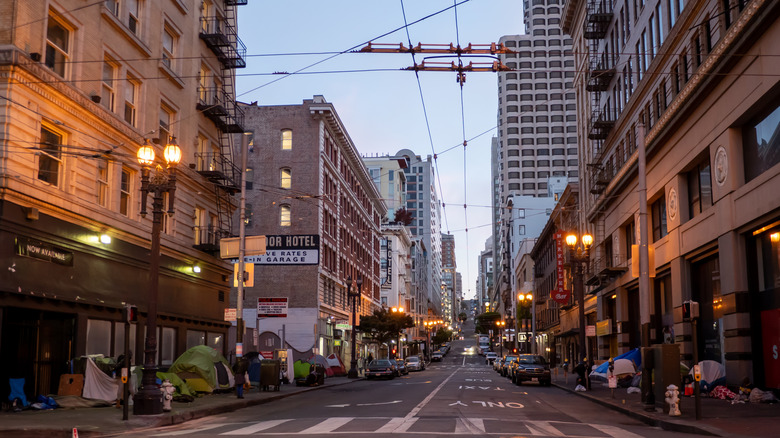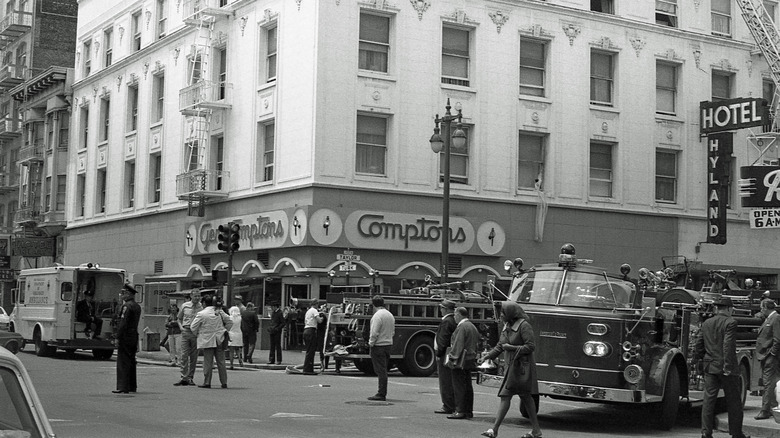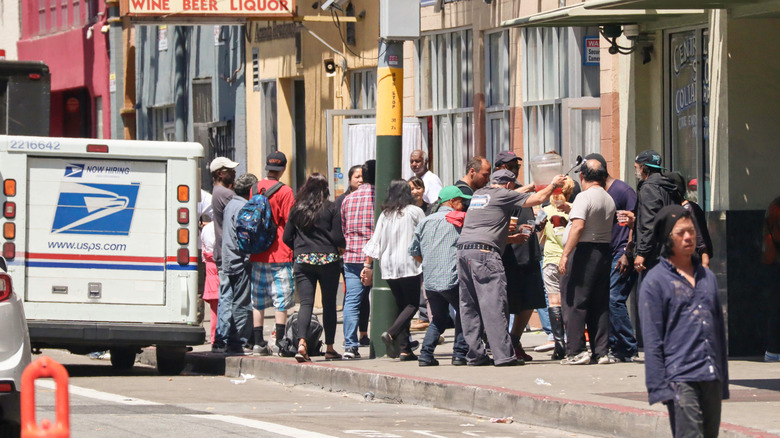The San Francisco Neighborhood Tourists Should Avoid If They Want To Stay Safe While Exploring The City
San Francisco is one of America's greatest cities, a cosmopolitan playground filled with endless culture, spectacular global cuisine, breathtaking coastal views, and a distinctly progressive spirit. But the "City by the Bay" also houses a gritty underbelly that's rarely seen by the majority of its 25.5 million tourists, who flock to landmarks like the gleaming Golden Gate Bridge and serpentine Lombard Street. For adventurous travelers who prefer to skip tourist traps like Fisherman's Wharf and go off the beaten path, one neighborhood in particular should be avoided if you want to stay safe while exploring the city. Don't even think about setting foot in the crime-riddled Tenderloin District, home of what some have said is the world's largest open-air drug dealing market.
The Tenderloin District, or simply the Tenderloin, takes up five square blocks in San Francisco's densely packed downtown. The neighborhood is bordered by Geary Street to the north, Market Street to the south, Mason Street to the east, and Van Ness Avenue on its western edge. Within these borders, a thriving drug and crime ring is emboldened to operate because the city's resources and law enforcement are stretched too thin. Criminals and homeless or drug-addicted people live in tents lining filthy streets where all manner of drug use is visible to the naked eye.
Two thirds of drug crimes reported in San Francisco take place in the Tenderloin. Assault and robberies are ubiquitous, and drug overdoses are a regular occurrence. In 2025 alone, over 40% of drug overdoses in San Francisco have been in the Tenderloin and its neighboring SOMA district. While you might catch the visible presence of law enforcement or social outreach workers, tourists might want to consider avoiding the Tenderloin at all costs.
The Tenderloin's complex history as a containment zone for vice
How did the Tenderloin wind up here? Because, as Katie Conry, the Executive Director of the Tenderloin Museum, told ABC7 News, it was basically designed as a hotspot for the city's vice. The Tenderloin emerged in the aftermath of the devastating 1906 San Francisco earthquake. The district was built to house workers rebuilding the city, with single occupants living in single rooms. It swiftly became a seedy replacement for the nearby and notorious Barbary Coast, which had seen its red-light activities run out of town. The Tenderloin thrived during prohibition, becoming San Francisco's go-to spot for carnal and nefarious indulgence.
A haven for people and activities outside of the mainstream, it's no surprise that the Tenderloin became the cradle of San Francisco's queer civil rights movement in the 1960s. The Tenderloin's Transgender District, the first such legally recognized district in the world, commemorates the historic 1966 queer and transgender uprising at Compton's Cafeteria. The population began to explode in the 1970s with the arrival of many diverse communities, includingSoutheast Asian refugees who arrived after the fall of Saigon. Today, the population density of the Tenderloin approaches 72,000 residents per square mile. 3,500 of these are children, the largest concentration in San Francisco.
In 2008, the Tenderloin joined other historic San Francisco neighborhoods in being recognized on the National Register of Historic Places. Whether because, or in spite of, the Tenderloin's history of vice, diversity, and social unrest, it has inspired and infiltrated popular culture. Jazz greats Thelonious Monk, Miles Davis, and Dave Brubeck have played in its clubs. Iconic rock bands like the Grateful Dead and Santana have recorded in the Tenderloin's studios. The author Dashiell Hammet wrote the "The Maltese Falcon" while living in the Tenderloin in the '20s.
Where efforts to clean up the Tenderloin stand
Efforts to clean up the Tenderloin are targeted and ongoing. Many social services, local foundations, and charities operate in the neighborhood to provide hope and relief for its grim drug problem.
Law enforcement crackdowns backed by the DEA, FBI, and U.S. Justice Department ramped up in 2024. These multi-agency efforts resulted in 20 federal criminal complaints, which potentially carry stiffer punishments for offenders than state laws. Raids on nighttime drug dealing ramped up while authorities blanketed the Tenderloin with surveillance equipment. One particular operation that targeted fugitives with outstanding arrest warrants netted 57 arrests in a single day. A local drug user named J.J. told CBS News that he believed the crackdown was working to curb the flow of narcotics: "What I'm noticing is that during the day it is difficult to find at all."
However, even with this kind of progress, the Tenderloin remains unsafe for the average tourist. While the Tenderloin doesn't boast the outrageous violent crime rates that the most dangerous cities in America do, it's still best to avoid this San Francisco neighborhood during the day, but especially at night.


